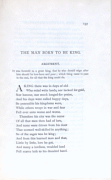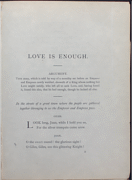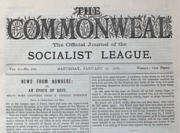

Morris himself became a prolific and celebrated writer. His literary production, like his reading, was wide-ranging: during his lifetime he wrote poems, translations, book reviews, bellettristic essays, short stories, and prose romances, including a number of works advocating English socialism. His best-known writing was his poetry and it has been argued that only his controversial political beliefs kept him from accepting an appointment as Britain’s poet laureate.
Although Morris’s works are diverse and voluminous, they tend to reflect a number of common concerns: an interest in creating visually pleasing images; a fascination with the medieval and Gothic; and a sense of disappointment with the uniformity, tedium, and injustice of modern industrial capitalism.
 The Oxford and Cambridge Magazine, Vol. 1, January-December, 1856. London: Bell and Daldy.
The Oxford and Cambridge Magazine, Vol. 1, January-December, 1856. London: Bell and Daldy.
In 1856, recent Oxford graduate William Morris and a number of artistically minded friends founded the short-lived Oxford and Cambridge Magazine, a ten-issue experiment in literary miscellany. Morris’s many contributions to the publication--from a glowing review of a new poetic volume by Robert Browning to an essay praising the medieval churches of Northern France as “the grandest, the most beautiful, the kindest and the most loving of all the buildings that the earth has ever borne”--anticipate what would prove to be lifelong passions.
As shown here, Morris dramatizes his obsession with medieval architecture in an eerie short story, “A Night in a Cathedral,” which recounts the fearful experiences of a man enveloped, as night falls, by an ancient church’s spirits, skeletons, and gargoyles. By the tender age of twenty-two, Morris loved the mythical honor and mystical beauty that he associated with Gothic architecture and medieval literature.
![Def. of Guenev, p. [241]](jb02-200.gif) William Morris. The Defence of Guenevere and Other Poems. First edition. London: Bell and Daldy, 1858.
William Morris. The Defence of Guenevere and Other Poems. First edition. London: Bell and Daldy, 1858.
Morris continued to write prolifically, as he would for the remainder of his life. Like Malory and Tennyson before him, Morris became captivated by the historical resonance and dramatic potential of the Arthurian myths. Two years after The Oxford and Cambridge Magazine, Morris published his first volume of poetry, The Defence of Guenevere, a work which included poems contemplating Arthur’s tomb and the Christmas mystery of Sir Galahad. Although the volume sold fewer than three hundred copies, it brought Morris to the attention of London critics, whose responses were profoundly mixed. Some reviewers praised the young poet’s ability to describe medieval characters like a contemporary, while others attacked his plain language and archaic subject matter.
The Defence of Guenevere highlights two of the great loves of Morris’s life. With its dedication to Dante Gabriel Rossetti and its vivid portraits of Arthurian figures, the work reflects Morris’s poetic interest in the aesthetic principles and techniques of the Pre-Raphaelite painters. The passage included here points to another primary inspiration for Morris’s verse: a certain lady “of ivory/Forehead, straight nose, and cheeks that be/Hollowed a little mournfully.” The lady, Jane Burden, is the same woman he tried to paint. His “La Belle Iseult” is his only known completed work in oil, finished during the same year as this poem. It was the work which caused Morris such frustration that he scrawled on the back of the canvas, “I cannot paint you, but I love you.”
 William Morris. The Earthly Paradise. London: F. S. Ellis, 1868.
William Morris. The Earthly Paradise. London: F. S. Ellis, 1868.
The 1860s proved to be a remarkably busy decade, even by Morris’s frenetic standards. Between 1859 and 1868, he married Jane Burden, had two daughters with her, founded his artistic firm Morris, Marshall, Faulkner & Co., designed his first wallpaper, and wrote two long works: The Life and Death of Jason and The Earthly Paradise.
The Earthly Paradise , his most popular work during his lifetime, recounts the stories of a group of friends who have reunited after fleeing their diseased city. Both Morris’s narrative structure and his fictions reflect his knowledge of earlier literature. His well-travelled storytellers resemble the characters of Boccacio’s Decameron and Chaucer’s Canterbury Tales, while his stories originate from medieval, classical, Eastern, and Norse legends.
With such stories as “The Man Born to be King,” “The Lady of the Land,” and “The Watching of the Falcon,” the poem’s popularity has been attributed to its vivid imagery and marked literary escapism. Recent critics have suggested that the poem is more than mere fantasy, however; the wistful descriptions of utopian life often implicitly lament the boredom and lack of imagination in modern industrial society.
The edition shown here appears to have been designed and laid out without much input from Morris. This rather plain text can be compared with the elaborate ornamentation and typographic imagination that Morris would later exhibit in his Kelmscott Press publications.
William Morris. Love is Enough. Boston: Roberts Brothers, 1873, and  Hammersmith: Kelmscott, 1897.
Hammersmith: Kelmscott, 1897.
Morris’s affection for ancient literature led him to experiment with literary form as well as archaic language. In his 1873 work, Love is Enough, Morris attempted to imitate the alliterative language and complex metrical structure of old English poetry. As his daughter wrote years later, the work “is the most elaborate scheme the poet ever worked on, and shows his most sensitive touch.” Dante Gabriel Rossetti read an early draft of the poem and wrote in a letter that, “The poem is, I think, at a higher point of execution perhaps than anything he has done--having a passionate lyric quality such as one found in his earliest work, and of course much more mature balance in carrying out. It will be a very fine work.”
 The poem was written in the form of a masque (an elaborate morality play interspersing poetry and music) that was to be performed as part of the wedding celebration of a fictional emperor and empress. Appropriately enough, the masque tells the story of a mighty king who is tested by sickness and age and ultimately abandons his throne for the woman of his dreams. The ruler loses all his power and fame but considers himself blessed in his love.
The poem was written in the form of a masque (an elaborate morality play interspersing poetry and music) that was to be performed as part of the wedding celebration of a fictional emperor and empress. Appropriately enough, the masque tells the story of a mighty king who is tested by sickness and age and ultimately abandons his throne for the woman of his dreams. The ruler loses all his power and fame but considers himself blessed in his love.
This elaborate story becomes more poignant when one considers the fact that Morris’s own marriage was showing signs of strain. The masque’s romantic title can also be read as ironic or wistful.
These two editions illustrate the close link between text and image in Morris’s writing. His recent biographer, Fiona MacCarthy, argues that Morris’s poem was conceived as a picture book with elaborate borders and woodcut drawings by Burne-Jones. The 1897 edition, published posthumously by Morris’s Kelmscott Press, restores the work’s intended form, which had been left out of earlier editions. In contrast to the stark printing of the first edition, the opening pages of the Kelmscott edition quickly establish the work as magical and mythical while calling the reader’s attention to the young newlyweds who are witnessing the masque.
 William Morris. “News from Nowhere,” in The Commonweal, Vol. 6 (No. 209), January 11, 1890.
William Morris. “News from Nowhere,” in The Commonweal, Vol. 6 (No. 209), January 11, 1890.
Late in his life, Morris returned to periodical publication, an activity he had largely abandoned after the Oxford and Cambridge Magazine of 1856. In 1885, he began publishing The Commonweal, a weekly journal affiliated with a political organization called the Socialist League. Morris printed news, editorials, book advertisements, and calendars of political meetings in the interest of informing and unifying his socialist readers.
The journal also provided a forum for serialized fiction and Morris wrote several politically charged “propaganda romances” for publication. Between November 1886 and January 1887, he published “A Dream of John Ball,” a story of a nineteenth-century man who dreamed that he was taking part in the unsuccessful Peasants’ Rebellion of 1381.
Then from January to October of 1890, Morris printed another political romance, “News from Nowhere,” in The Commonweal. Like his earlier romance, “News from Nowhere” recounts the experiences of a nineteenth-century dreamer. The protagonist, William Guest, awakes to find himself in a utopian England in the twenty-first century. After a revolution in 1952, society has lost capitalistic desires for profit and industrial production; instead people create out of a joy in craftsmanship and beauty. Morris was consistent in his writing and living: the wide-ranging painter, designer, craftsman, and writer depicted perfect freedom as the ability to choose one’s own economic and creative pursuits. His future society fosters individualism, and even calls some British institutions into question. His citizens, for example, use the otherwise obsolete Houses of Parliament as storage space for excess dung.
“News from Nowhere” was deliberately controversial. The narrative had been written partially as an attack on a recent publication called Looking Backward, by American writer Edward Bellamy, in which an ideal society is comprised of citizens comfortably working away at their designated tasks, where every material want is satisfied, and all citizens are rapturous about the wondrous, machine-like utilitarianism. “A horrible Cockney nightmare!” declared Morris.
Many contemporary readers praised the sanity and practicality of Morris’s vision, although others were shocked by its suggestion that utopia would be secular. In choosing to emphasize material conditions for his future Britons, Morris marked himself as either refreshingly clear-minded or shockingly impious to those around him.
| INTRODUCTION | BIOGRAPHY | SOCIALISM | KELMSCOTT |